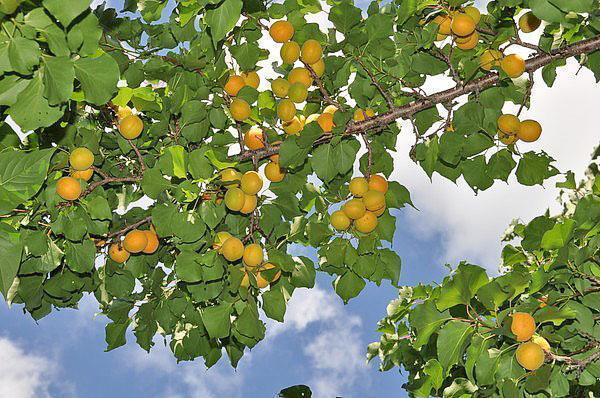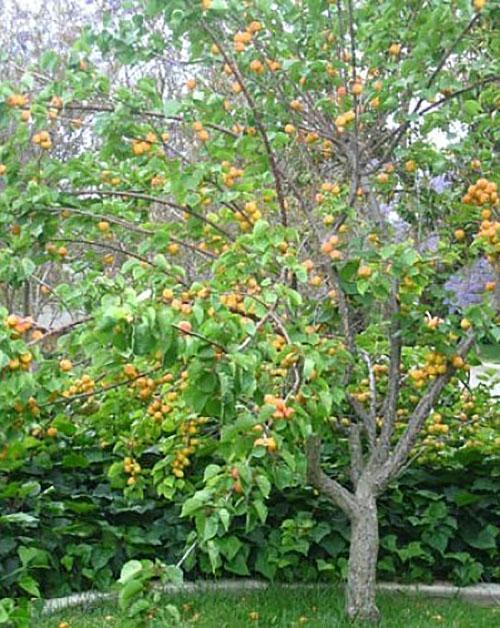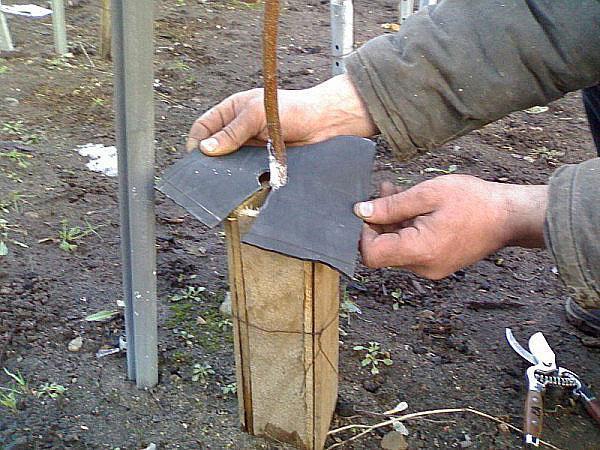An experienced summer resident can grow an apricot in central Russia
 The middle zone of Russia is characterized by snowy mild winters, with short-term frosts up to -300, humid warm summers, moderate continental climate. A native of the southern edges of the apricot, planting and care in the middle lane requires special. The European Plain includes regions from Belarus to the Volga region, from the borders of the Arkhangelsk region to the Black Earth region. In the north, the area is limited by the taiga, in the south - by the forest-steppe.
The middle zone of Russia is characterized by snowy mild winters, with short-term frosts up to -300, humid warm summers, moderate continental climate. A native of the southern edges of the apricot, planting and care in the middle lane requires special. The European Plain includes regions from Belarus to the Volga region, from the borders of the Arkhangelsk region to the Black Earth region. In the north, the area is limited by the taiga, in the south - by the forest-steppe.
Apricot requirements

Not all soil and terrain are suitable for growing apricots. The winter hardiness of the zoned varieties is limited, the trees need protection from winter temperature extremes and diseases. It is recognized that it is possible to plant an apricot orchard if external factors are observed when planting and caring for apricots in the middle lane:
- for landing, a slope with maximum illumination during the day is selected;
- groundwater should be low, no closer than 2 m to the surface;
- there must be a curtain from the north wind, a wall of a house, a fence or a protective screen;
- choose seedlings should be self-fertile winter-hardy varieties;
- the soil should be warm, fertile with plenty of earthworms.
Raising the landing site 70 cm above the ground will help the hill warm up faster. The roots rise higher from the groundwater. A saucer is arranged to moisten. An adult apricot does not require frequent watering.
Planting an apricot garden
 Every gardener dreams of getting the first harvest from a seedling as soon as possible. Perhaps, if you plant apricots in spring with container-type seedlings on stem formers. Wild plums, local varieties that do not freeze out, are used as a stock. The apricot is grafted at a level of 1.2-1.5 m from the base. Grafting into the trunk at such a height protects the apricot trunk from podoprevaniya - the troubles of trees near Moscow. The winter hardiness and productivity of apricot increases. As a scion, zoned varieties can be used. These seedlings are sold in containers. You need to purchase planting material only in nurseries.
Every gardener dreams of getting the first harvest from a seedling as soon as possible. Perhaps, if you plant apricots in spring with container-type seedlings on stem formers. Wild plums, local varieties that do not freeze out, are used as a stock. The apricot is grafted at a level of 1.2-1.5 m from the base. Grafting into the trunk at such a height protects the apricot trunk from podoprevaniya - the troubles of trees near Moscow. The winter hardiness and productivity of apricot increases. As a scion, zoned varieties can be used. These seedlings are sold in containers. You need to purchase planting material only in nurseries.
 Planting apricots in the middle lane, seedlings of zoned varieties with an open root system can be kept. The best time for planting is the end of April. The young plant must be protected from recurrent frosts. Local selection of plants with swollen but closed buds is chosen. Such a seedling will yield a harvest in 4-6 years.
Planting apricots in the middle lane, seedlings of zoned varieties with an open root system can be kept. The best time for planting is the end of April. The young plant must be protected from recurrent frosts. Local selection of plants with swollen but closed buds is chosen. Such a seedling will yield a harvest in 4-6 years.
 You can keep the dried seeds from native trees and plant the apricots in the fall. To do this, prepare a trench, fill it with loose fertile soil, put bones, sprinkle with earth and mulch with straw or hay. Natural stratification will take place, and young seedlings will sprout in the spring, but not all. Planting and caring for seedlings consists in creating a crown, providing conditions for rapid development and protection from diseases and pests.
You can keep the dried seeds from native trees and plant the apricots in the fall. To do this, prepare a trench, fill it with loose fertile soil, put bones, sprinkle with earth and mulch with straw or hay. Natural stratification will take place, and young seedlings will sprout in the spring, but not all. Planting and caring for seedlings consists in creating a crown, providing conditions for rapid development and protection from diseases and pests.
A feature in the care of apricots is the need to regulate the yield, and the formation of the fruit tree throughout its life.
Do apricots grow in the Urals and Siberia
 More recently, an amateur who demonstrates apricots at an exhibition of dacha gifts was shamed by local gardeners, reproached for having brought the purchased fruits. It was a local enthusiast Nikolai Pavlovich Pitelin from Chelyabinsk. He began the introduction of apricot in the Urals by using it as a seed for the rootstock of semi-crops of the local station - poles.
More recently, an amateur who demonstrates apricots at an exhibition of dacha gifts was shamed by local gardeners, reproached for having brought the purchased fruits. It was a local enthusiast Nikolai Pavlovich Pitelin from Chelyabinsk. He began the introduction of apricot in the Urals by using it as a seed for the rootstock of semi-crops of the local station - poles.
For 6 years he was looking for material for the scion. In 1992, I received cuttings of the varieties Khabarovsk and Akademik from Khabarovsk and grafted them onto 6 year old local seedlings. Then he received zoned varieties from the first grafts, and introduced Krasnoyarsk varieties - Seraphim and Amur.
As a result, I got local zoned varieties, the cuttings from which I handed out to amateur gardeners. Apricots have taken root in the Urals. In the coldest winters, when apple and cherry trees died, apricots survived. But during the flowering period, it is difficult to protect them from return frosts, which are not uncommon in the Urals. From ten years, apricots bore fruit 6 times, in other years the harvest died in bloom. But then they suffered and apple trees, pears, plums.
In the Ural region, it is recommended for cultivation:
- Amur variety, medium-sized tree, with fruits weighing 30 g, sweet, yield up to 40 kg in favorable years, partially self-fertile;

- Seraphim variety, fruits weighing up to 30 g, slightly mealy, sweet and sour pulp, yield up to 30 kg; self-fertile variety;

- variety Khabarovsk, vigorous, spreading, yield up to 35 kg, self-healing quickly, fruits on the taste scale 4 points;

- sort Akademik, vigorous, fruits weighing up to 55 g, taste 4 points.

Apricot planting in Siberia, in the zone of risky farming, is also carried out by local mortars. The tester Ivan Leontyevich Baikalov has been breeding here for 40 years, the Minusinsk fruit nursery has been created in Khakassia. Baikalov's work to improve local varieties did not create a breakthrough, but as a rootstock they are used in the Ural and South Siberian regions.
However, there are several varieties that are winter-hardy, leave in bloom from recurrent frosts and are used in further breeding work:
- Sibiryak Baikalova was created on the basis of an unknown variety imported from the Far East. The variety was created in Khakassia on a private plot, registered in 2002 by the State Register. The tree is 3.5 m high, spreading, does not thicken, bouquet-type fruit buds.
- East Siberian - a hybrid of the ordinary and Manchzhurskiy varieties. Feature - blooms in mid-May. Fruits 25-35 g, tasty, sweet core.
- Northern Lights is a third generation hybrid created in collaboration with Matyunin. The hybrid has high frost resistance. Apricot blooms in the second decade of May, Avoids return frosts.
 The peculiarity of growing Siberian apricots in planting is only on the hills, and there should be enough land so that the roots do not freeze in winter. Planting several varieties is required, since there are no zoned self-fertile varieties. No trimming per ring is allowed. It is necessary to protect the health of the tree, which is difficult to survive in Siberian conditions.
The peculiarity of growing Siberian apricots in planting is only on the hills, and there should be enough land so that the roots do not freeze in winter. Planting several varieties is required, since there are no zoned self-fertile varieties. No trimming per ring is allowed. It is necessary to protect the health of the tree, which is difficult to survive in Siberian conditions.